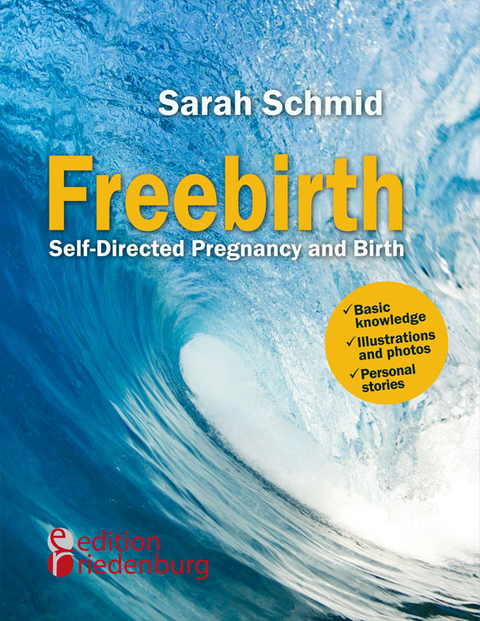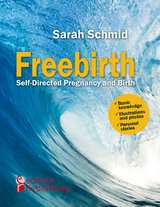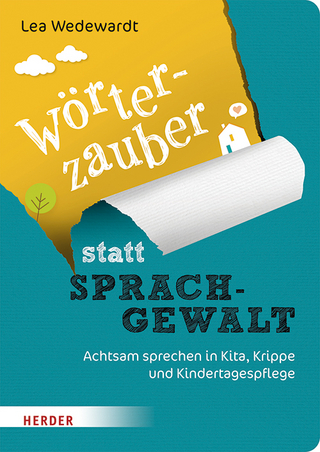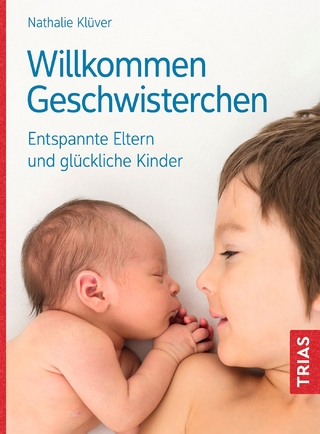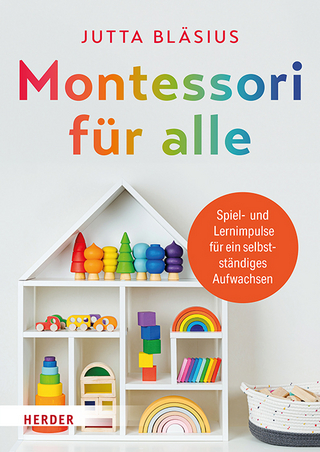Freebirth - Self-Directed Pregnancy and Birth
edition riedenburg (Verlag)
978-3-902943-86-6 (ISBN)
Sarah Schmid, Physician and mother of six children. Five of those children were born during planned freebirths. For several years, she has been an internet presence on self-directed pregnancy and birth. Her videos have had millions of views. Now she has found her voice in her first book, which strives, through information, to empower pregnant women and their partners. www.freebirth.me
Introduction 9In the beginning. 10My journey to freebirth 11What to expect from this book 18About responsibility, fear and safety 19Responsibility and other people's fear 20Dealing with your own fears 21The question of safety 23Nutrition as key for healthy pregnancy and birth 29The recipe for success from ancient civilisations 30Rule 1: Sugar: very little and natural 30Rule 2: Carefully prepared grains 30Rule 3: The whole animal is edible 31Rule 4: Fat is best 31Rule 5: Dirt is not the enemy 32Rule 6: Sauerkraut as medicine 33Rule 7: Daily consumption of raw milk 33Rule 8: Particular foods that prepare for pregnancy 33Important vitamins and minerals for pregnancy and breastfeeding 34Calcium and Vitamin D 34Magnesium 34Iron 34Zinc 35Vitamin B6 35Vitamin B12 35Folic Acid 35Practical Pregnancy 37Pregnant? 38What happens in the weeks of pregnancy? 38About moods and sensitivities 39The best care 39Finding a good midwife 40Doula, friend, partner - different considerations about your birth partner 42When you need an obstetrician 42What do your notes actually mean? 43The estimated date of birth (EDB/EDD) 43Your history, general test results and pregnancy specific test results 43Screening for sexually transmitted infections - syphilis, HIV, hepatitis B, chlamydia 44Screening for gestational diabetes - Glucose Tolerance Test, urinalysis 44Rubella Titre 45Screening for pre-eclampsia - urinalysis, blood pressure, weight 45Haemoglobin (iron) levels 46Determining your blood group and rhesus factor 46Screening for chromosomal abnormalities, hereditary diseases and malformations 48Group B Streptococcus 48Urinalysis for leukocytes and red blood cells 49Fetal position and presentation, fundus, heartbeat and other pregnancy checks 49Ultrasound 51Possible models of care 53Common pregnancy ailments 53Nausea 53Sciatica 54Varicose veins 54The symphysis and other joints 55Stretch marks 56Constipation 56Muscle cramps 56Dental caries 57Self-directed Pregnancy 57What position is the baby in? 57Breech presentation 61Transverse and oblique lie 63Other ways to determine the baby's position 63Where is the placenta? 65Is the baby well? 66Freebirth for a first baby? 66Is it twins? 67Bleeding 68When pregnancy ends too soon 69Preparation for birth 70What do I need for a self-directed birth? 70Perineal massage? 71Traumatic and unpleasant previous birth experiences 72Practice run in your mind 72Practical Birth 75To start with: good and bad births? 76A completely physiological birth 77First stage of labour 78Transition 79Second stage of labour 79Third stage of labour 80'Rest and be thankful' phase 80Birth on land 80Birth in water 82What if. 82. I am overdue? 82. the baby is big? 84. my waters break but contractions don't start immediately? 84. I go into labour too soon? 85. contractions are painful but labour does not progress? 85. there is a cord prolapse? 87. I have an anterior lip of cervix, like I did during a previous birth? 88. there is fetal distress and I don't notice? 89. there is meconium? 89. the shoulders get stuck? 90. the cord is around baby's neck? 90. the baby doesn't breathe? 91. the baby inhales some of the amniotic fluid? 92. the placenta takes a long time to come out? 92. I bleed heavily after the birth? 94Birth and pain 98Protecting the perineum, episiotomy and perineal tears 99Cutting the cord - how, when and what with? 101Checking the placenta 104Freebirth under difficult circumstances 105When you don't have any support 105Freebirth and breech presentation 106Freebirth after caesarean section 108If you have to go to hospital 110Plan B - Emergency Birth Plan 112The legal side 113The chapter for men, by men 115Our journey to freebirth, together 116'I could not manage to get rid of my fears.' 117When the midwife makes a mistake - an interview 120The baby is born 123The first hour with your newborn 124Breastfeeding and the family
* My journey to freebirth * My first foray into modern obstetrics happened before my first pregnancy. During my time in medical school I had various shorter placements in hospitals as well as a whole year at a later point in my studies. I knew I wanted to have children and used the opportunity to take up a placement in the obstetrics and gynaecology department of my local hospital. I didn’t have any preconceived ideas about birth, was curious and excited about every birth I was allowed to attend. Once I even saw twins born. And once, but only once did I witness a birth in an upright position, rather than with the woman on her back, as usual. I observed the organisation of the nursery and assisted with caesarean sections. I had to suction the amniotic fluid as soon as the amniotic sac was opened. The doctors were all relatively nice. The midwives were all very different. I still remember one very young midwife who attended the upright kneeling birth mentioned above with me. Her cheeks always turned bright red as birth approached and she never had to check the mother’s cervix to know it was fully dilated. This gut feeling impressed me amidst all the technology and monitoring. My next experience of obstetrics was during my year long placement. I was married by then, pregnant with my first baby and was therefore hardly allowed to do anything clinical such as take bloods. Watching was allowed though and watch I did. This time my placement was in the biggest hospital in town. I spent two month in the very labour ward I was born in myself. The midwives were the type famous in the former East Germany and tone in general was regimental. The women were shouted at and insulted if they didn’t follow the midwives’ instructions. A generous episiotomy was routine and seemed very painful although the women were usually reassured that it wouldn’t be. The student midwives tried to trump each other with the the numbers of episiotomies they had performed. There were many situations I found horrifying and the decision to have a homebirth was an easy one. The risk of having to birth in this hospital was not one I was willing to take. My husband was in agreement as the hospital was only 5 minutes away from our house at the edge of the woods and was easily accessible in the case of an emergency. Through recommendation I found and older, experienced midwife. I had a good feeling about her and felt like nothing could go wrong. The year long placement I was doing at the time was very stressful. 4 months of it took place in Accident and Emergency. It was exciting and educational but I got very constipated. I found a very reliable remedy for this, which brought relief in 15 minutes flat: the forest. As soon as I went for a walk there, I felt like everything started to move again, as it were. As I wandered amongst the trees and felt relief take over, I thought again and again: I have to birth my baby right here. I’m just going to escape, without anyone knowing where I am and come back with a baby. No trouble, no stress, no expectations, demands or clocks. That would be amazing. If I can get rid of constipation so easily here, it must be the ideal place to push out a baby.
* My journey to freebirth *My first foray into modern obstetrics happened before my first pregnancy. During my time in medical school I had various shorter placements in hospitals as well as a whole year at a later point in my studies.I knew I wanted to have children and used the opportunity to take up a placement in the obstetrics and gynaecology department of my local hospital. I didn't have any preconceived ideas about birth, was curious and excited about every birth I was allowed to attend. Once I even saw twins born. And once, but only once did I witness a birth in an upright position, rather than with the woman on her back, as usual. I observed the organisation of the nursery and assisted with caesarean sections. I had to suction the amniotic fluid as soon as the amniotic sac was opened.The doctors were all relatively nice. The midwives were all very different. I still remember one very young midwife who attended the upright kneeling birth mentioned above with me. Her cheeks always turned bright red as birth approached and she never had to check the mother's cervix to know it was fully dilated. This gut feeling impressed me amidst all the technology and monitoring.My next experience of obstetrics was during my year long placement. I was married by then, pregnant with my first baby and was therefore hardly allowed to do anything clinical such as take bloods. Watching was allowed though and watch I did.This time my placement was in the biggest hospital in town. I spent two month in the very labour ward I was born in myself. The midwives were the type famous in the former East Germany and tone in general was regimental.The women were shouted at and insulted if they didn't follow the midwives' instructions. A generous episiotomy was routine and seemed very painful although the women were usually reassured that it wouldn't be. The student midwives tried to trump each other with the the numbers of episiotomies they had performed.There were many situations I found horrifying and the decision to have a homebirth was an easy one. The risk of having to birth in this hospital was not one I was willing to take. My husband was in agreement as the hospital was only 5 minutes away from our house at the edge of the woods and was easily accessible in the case of an emergency.Through recommendation I found and older, experienced midwife. I had a good feeling about her and felt like nothing could go wrong. The year long placement I was doing at the time was very stressful. 4 months of it took place in Accident and Emergency. It was exciting and educational but I got very constipated.I found a very reliable remedy for this, which brought relief in 15 minutes flat: the forest. As soon as I went for a walk there, I felt like everything started to move again, as it were. As I wandered amongst the trees and felt relief take over, I thought again and again: I have to birth my baby right here. I'm just going to escape, without anyone knowing where I am and come back with a baby. No trouble, no stress, no expectations, demands or clocks. That would be amazing. If I can get rid of constipation so easily here, it must be the ideal place to push out a baby.
| Erscheint lt. Verlag | 26.3.2015 |
|---|---|
| Sprache | englisch |
| Maße | 170 x 220 mm |
| Gewicht | 430 g |
| Einbandart | Paperback |
| Themenwelt | Sachbuch/Ratgeber ► Gesundheit / Leben / Psychologie ► Schwangerschaft / Geburt |
| Schlagworte | abnormal • Abortion • Alleingeburt • alone • angel care • angelcare • atenatal • Babies • Baby • babycare • Background • Ball • basin • Birth • birth experience • birthing centre • birth in water • birth plan • birth pool • birthpool • blood group • Book • books • Born • Breast • Breastfeeding • breech • Caesarean • Care • Center • Cesarean • Child • Childbirth • chromosomal • Constipation • Cord • cramps • C-Section • Diabetes • Doctor • Doula • DVD • EASY • easy birth • Effective Birth Preparation • Emergency • Emotions • episiotomy • Experience • Experiences • Factor • fear • Fears • Feeding • feelings • figure • Figures • first-time parent • Fitness • fitness ball • Fixies • folic acid • For Dummies • Foto • Free • Gaskin • geburtspool • guide to childbirth • gynaecologist • Haemoglobin • head down • homebirth • hormones • Hospital • HypnoBirthing • Illustrations • Ina • Ina May • ina may's guide to childbirth • instruction • Instructions • iron • Jesus • Kate • Knowledge • la bassine • Labour • Lansinoh • Laura • Lebertran • levels • locia • Maggie Howell • Massage • meconium • Medical • Medicine • Method • Middleton • midwife • Mongan Method • Morgan • morgan method • mother • Mothers • Muscle • myself • natural birth • natural birth fitness • natural childbirth • nbf • Nutrition • obstetrician • orgasmic • orgasmic birth • painfree • painless • Pampers • PDA • pee • perineal • Personal • Photo • Photographs • Photos • Physiological • placenta • Plan • Planning • Pool • Position • Positive • Pregnancy • pregnancy yoga • Pregnant • Preparation • Professional • Ratgeber: Schwangerschaft, Geburt und Babypflege • relaxing birth music • Responsibility • responsible • Rhesus • rubella • SAC • SAFE • Safety • Sarah • Sarah Schmid • Sauerkraut • Schmidt • Schmitt • Screening • self-directed • shanley • SIDS • stage • Stages • still birth • Stillbirth • Stories • Story • stressless • stretch marks • Sugar • Tell • Telling • titre • Trauma • Traumatic • TWINS • Ultrasound • unassisted • unhindered • Video • Vitamin D • vitamins • walking PDA • waterbirth • what to expect • What to Expect when You're Expecting • Woman • Women • Yoga |
| ISBN-10 | 3-902943-86-6 / 3902943866 |
| ISBN-13 | 978-3-902943-86-6 / 9783902943866 |
| Zustand | Neuware |
| Haben Sie eine Frage zum Produkt? |
aus dem Bereich
